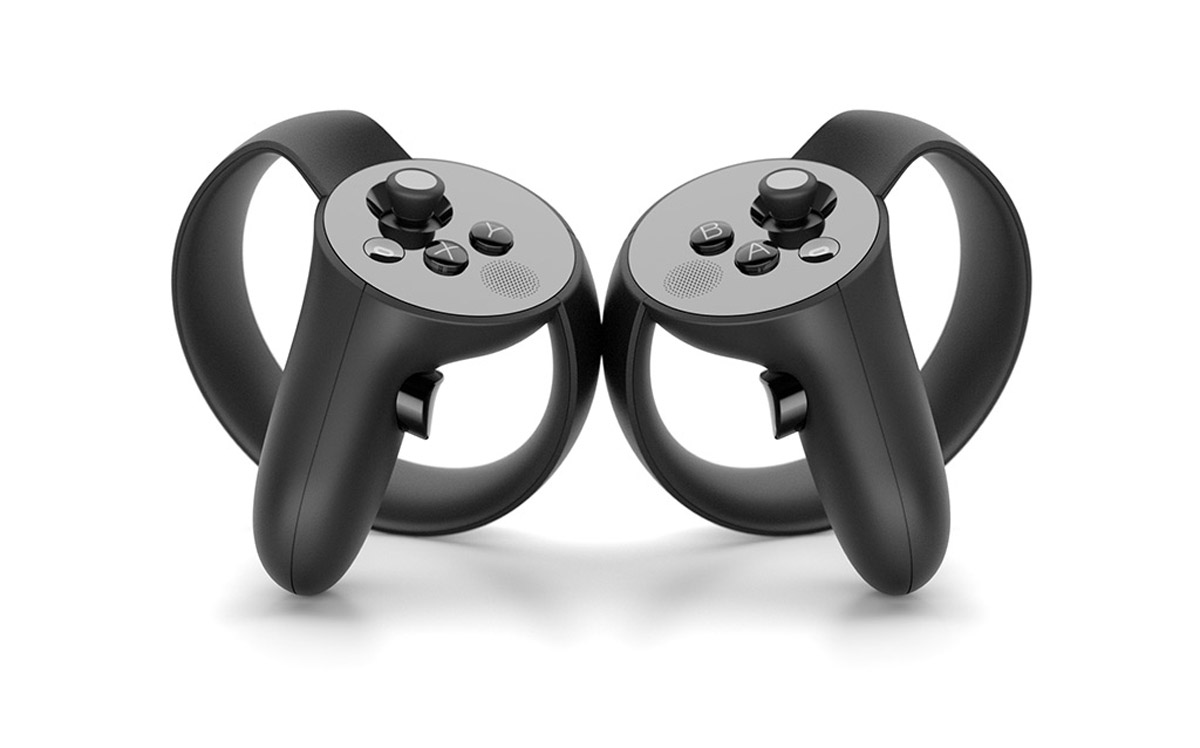Touch the sky, but don’t deadzone
VR has had a curious impact on the industry.
It’s not mainstream yet. It’s pricey. It’s unwieldy. Yet, it’s all executives and developers are talking about. We’re not quite at the apex of the “revolution,” but we do have platform wars currently raging full force with “big three” (HTC, Oculus, PSVR) — and this is with many other suitors (like Google) waiting in the wings.
In my home though, it’s welcome. Nine months later, and I’m still playing around with the Rift on a fairly regular basis. VR hasn’t taken over my core console and portable habits just yet, but it’s creeping in, especially after I got my hands on (and into) the Rift’s motion controls.
Product: Oculus Rift Touch
Manufacturer: Oculus
Input: One USB 3.0 port
MSRP: $199.99 (pair of Touch controllers)

What’s in the box:
As plain as day, everything you see in the above picture is what you’ll get from the $200 box. There’s two motion Touch controllers (more on those in a moment), a new sensor bar (which requires USB 3.0, and brings your sensor count to two), and a Rock Band adapter. I haven’t had a use for the latter yet, but it’s there, as are two AA batteries, one for each Touch remote.
Yes this means yet another USB port is taken up, bringing the Rift to a grand total of three USB and one HDMI. That hassle aside, the actual installation is just as painless as it was with the Rift proper. For the sake of testing I did try the new sensor in a USB 2.0 port, but found that it was a little more delayed in terms of tracking compared to the stellar performance on the suggest 3.0 port. So try to have a free one before you buy the Touch.

Setup:
After plugging in the new sensor, the Rift software automatically detects that you own Touch Controllers, and prompts you to slip one AA battery into each remote. The battery covers are clearly marked, and are sturdy enough where they won’t come undone accidentally, but can be popped off deliberately.
The UI then helpfully states which of the Touches is the left remote (if you couldn’t figure it out already, it has the X and Y buttons), and which is the right — pairing took all of 30 seconds for both controllers. How you handle the next step is entirely up to your ability to accommodate room-scale VR. Up until now, Oculus VR has suggested that you play the Rift sitting, but with the Touch that changes. Oculus requests that you place the sensors three to seven feet apart (and have a 5×7 foot play space), which was easily done on my large desk (I had mine at roughly four feet). For those of you who maybe only have a tiny one-monitor setup, you might need to do some finagling (like placing end tables on the sides) or move to a bigger desk.
For those of you who are clumsy, there’s a “Guardian System” feature that vibrates when you walk close to your desk, to prevent you from smashing into your monitors or flinging a sensor across the room. You can manually set these boundaries up yourself by “drawing” them wherever you wish.

The controller:
It’s one thing to imagine how well the Touch controllers work, and another to actually feel it. It’s a crazy 1:1 translation of your hand movements, especially the grip, which feels comfortable and mimics the movement of each finger. For most games with Touch support you can actually point with your index finger, and it will instantaneously detect your real finger and let you perform contextual actions like poking things in-game. The triggers are just perfect, as you don’t have to expend too much effort to press them in.
Deadzoning can be frustrating and take you out of the experience, so there’s more work to do from an R&D perspective that front. The sensors, as technically advanced as they are, still feel primitive when compared to the tech inside the actual Touch remotes. They can only detect the area in which you place them, so if there’s an item you want to grab that’s just out of reach, you’re out of luck.
This is why some titles have a crutch like “psychic Jean Grey powers” that let you pickup things that would otherwise send you into the deadzone. Or, request that you turn with the analog sticks instead of actually twirling around constantly, no doubt related to the other limitation of the headset being linked by way of a Matrix-esque cord coming out of your head. I hope this is smoothed out in the future by sensors with a wider array and wireless headsets, because picking up menial items like papers or files and organizing them is way more fun than it sounds — and I want even more freedom while doing it.
All of these stopgaps have led me to believe that once manufacturers can solve these problems and further subsidize the price, we might actually see more VR devices in more homes. For now, it’s still a niche hobby that I’m happy to partake in.

The games:
As expected, a lot of the initial offerings (which you can view in full here) range from “tech demo” to “this is a real game I’d pay money for.” But for the first time I feel like the Rift is at that point where it can “sell” VR to the mainstream. I had my wife play the puzzle-centric I Expect You to Die, and despite not being wowed by the concept of sitting down and playing VR games with a controller earlier this year, she liked the idea of trying something she’s never done before — even at a theme park.
For years I’ve been trying out so-called “VR” games at places like Disney Quest in Orlando, Florida, as well as the mostly defunct ESPN Zone, but they were basically just strapping a TV to your head. But with room-scale VR, some talented developers have been able to reach a level of immersion that has taken aback nearly everyone I’ve introduced the device to.
Many of those launch Touch games are still in early access, so much of VR is still the “promise” that’s been given to us for years on end now (the same goes for the Unity demo-heavy Steam storefront for the Vive, or the staggered launch for PSVR), but for me at least, it’s already there.

The verdict:
I appreciate that VR has already provided us with multiple ways to control and experience video games in its relatively short consumer-grade lifespan. You have your traditional remotes like the Xbox One controller for the Rift, the DualShock for the PS4, and motion controllers for all three major devices. This not only allows the developers freedom, but provides fresh experiences for all of us to play with, and helps keep VR as a whole more interesting.
But I’m not going to act like the Touch remotes aren’t expensive as hell, because they are. $200 smackeroos is a lot, especially since the headset itself is $600. That puts it in line with the $800 HTC Vive, and while Oculus had the higher ground of boasting a cheaper price point at launch, they’re now both pricey prospects.
If you’re already into your Rift and still play it regularly, I’d go for the Touch. Otherwise wait for a 2.0 version or another cheaper bundle.
[This review is based on hardware provided by the manufacturer.]




